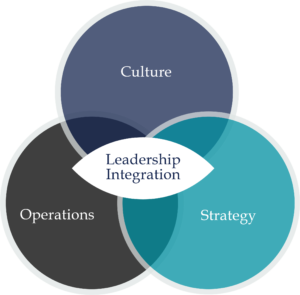Integrating New Leaders with Virtual Onboarding
In the current talent environment, doing everything possible to protect your investment in a strategic hire means committing to a strong Leadership Integration process. In the context of the global pandemic and preparing for a very different future, implementing this process through a strong Virtual Onboarding program is critical.
Leadership Integration is a strategic and intentional process that positions the new leader for accelerated assimilation by equipping them with a plan for success. This plan of action includes all the strategic elements of a new role, including functional, cultural and organizational leadership imperatives.
Significant time and financial investment has gone into filling a key executive position and yet, we know leaders are not always prepared and don’t always succeed in their transition:
- A Harvard Business Review (HBR) study reported that 61% of executives are not fully prepared for their new role and between 50-60% of executives fail within their first 18 months on the job.
- 32% of global executives rated the onboarding they experienced as poor and replacing each failed executive can cost a business significantly (HBR, August 2018).
An effective process provides the framework for defining what success means for a new leader – it’s a foundation for them to build from and understand what “excellence” will look like in their new role. It provides a comprehensive road map for the organization’s priorities. We must prepare and support the integration of new leaders and ensure resources are in place for them to be successful.
The shift from traditional onboarding to Leadership Integration is much more than just getting a leader started in their role. The typical onboarding process is only the beginning – but is an important first step. Even highly experienced executives are entering a completely new landscape and their previous success strategies might not transition successfully to their new one. They have to re-establish political capital, develop new relationships, learn the culture and connect with their team and new peers.
At Bedford and Teal we believe organizations need to be committed to an effective Leadership Integration process now more than ever. As companies strive to define a “new normal” in these complex times, there is relentless pressure on employers to ramp up new leaders earlier in their tenure so they have a more meaningful voice in defining the path forward. For the new leader, integration starts with a clear onboarding program that translates current practices into meaningful context. This includes:
1. Culture
- Engaging in and contributing to the culture and building relationships with their leadership team and key stakeholders
- Demonstrating alignment to the values of the organization through behaviours
2. Operations
- Establishing a complete picture and understanding of the operations and what the immediate and long-term issues are,
- Capturing and delivering quick wins
3. Strategy
- Defining the strategic intent of the existing plan and direction – moving to execution and implementation
- Determining the new direction, setting the compass and strategic initiatives going forward

Once an employer captures the organizational, cultural and strategic context, the key is to convey this information to the candidate in a way that will be meaningful to them so they can accelerate their ability to contribute tangible value. The move to virtual onboarding creates the opportunity to enhance current onboarding practices and move away from checklist procedures. The goal is to leverage the virtual environment to make a more personal introduction that gives the incumbent the opportunity for greater focus on establishing relationships – a key part of acclimatizing to the culture for a new leader.
The specific design parameters for a virtual Leadership Integration program will vary based on the unique features of the organization and the demands of the role. From our perspective at Bedford/Teal, there are a core set of elements that should be included in a best in class virtual onboarding program:
- Connects with the new hire in advance to understand their technology needs so they feel an instant tie into the organization
- Provides information and access to systems early so they feel prepared for their first meetings
- Ensures onboarding goals are clearly defined – the objectives of what needs to be learned are clearly outlined – both specific to the role and to the broader organization
- Provides them with a copy/framework of the on-boarding plan, so they know what to expect and feel like they belong
- Ensures several opportunities for personally connecting over Zoom, the phone or other meeting technology
- Establishes a personal reach out process – “who is connecting when?” – so there is an immediate opportunity to build a relationship.
- Has an inclusive approach of key stakeholders that reaches beyond HR to include representation of the people that are connected to this role
- Provides an opportunity to debrief from the recruitment/search process – if an assessment was used, what did it say? How can it be further explored?
- Establishes the career path from the beginning – retention is increased when employers show interest in the “career” right from the onboarding stage
- If employees know they are thought to have high potential it can be very motivating and engaging
While it may seem daunting to translate to a virtual environment and ensure all elements of onboarding are maintainted, virtual onboarding can be very effective and an even more personal process through actions that welcome the new leader to the team in a meaningful and intentional way.
In this competitive talent environment, organizations should be doing everything they can to optimize their investment and to continue to move forward building their teams with strategic hiring plans.
Bedford and Teal offer advisory services in Leadership Integration program development and execution. We advocate a customized virtual onboarding program that is structured over a period of time, with clear steps, stages, timelines and schedules, providing a 30, 60- and 90-day roadmap at the start. The entire Virtual Onboarding process may be delivered over the course of six months to a year.
We work with our clients and advise them to develop and establish an effective onboarding program now in order to retain their top talent. To learn about Bedford’s Leadership Virtual Onboarding Program, please email info@bedfordgroup.com.

